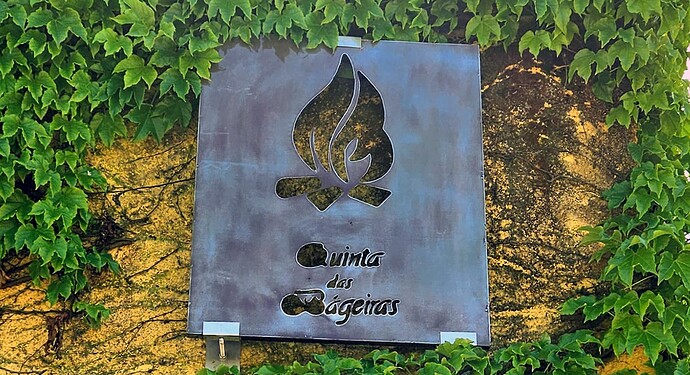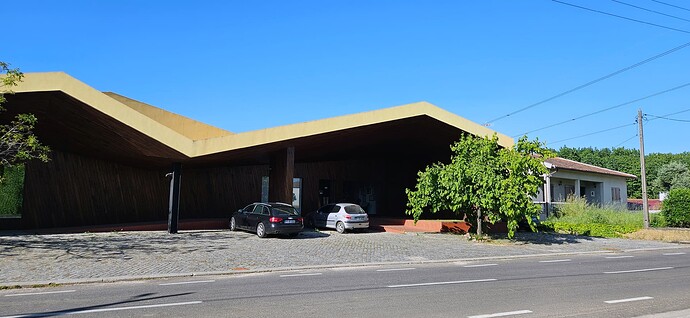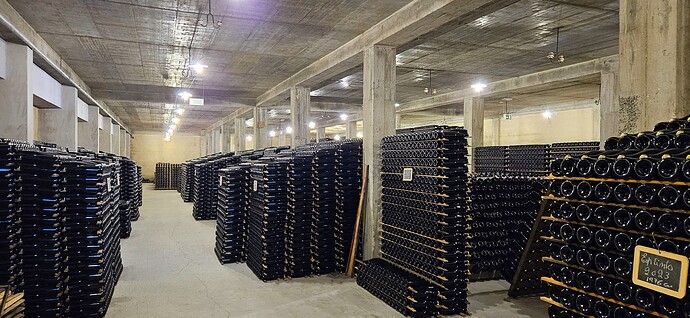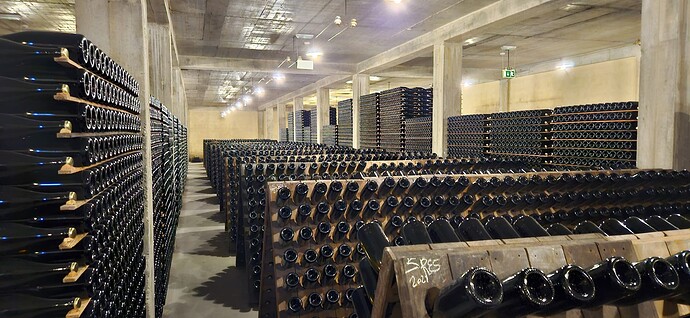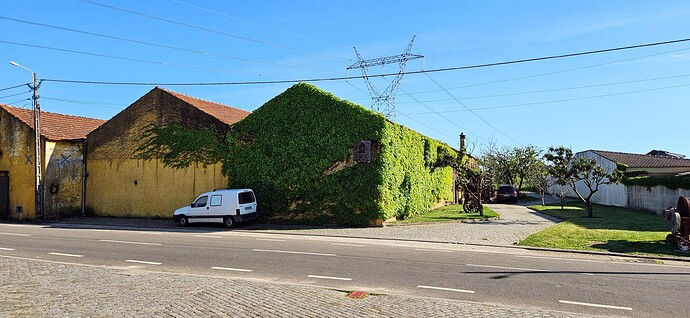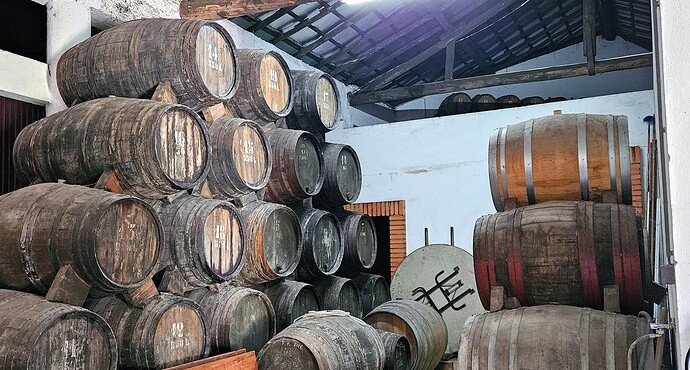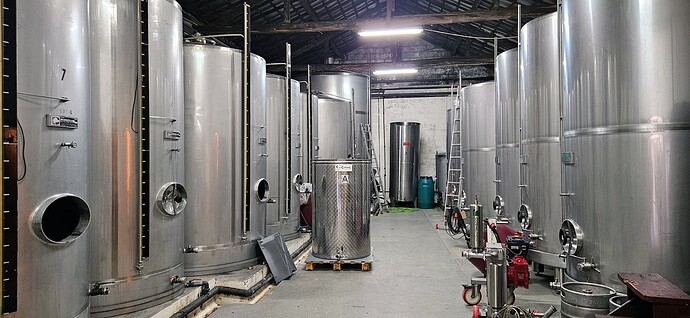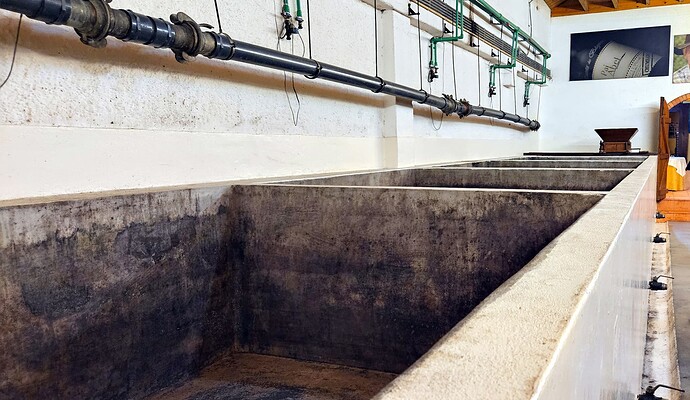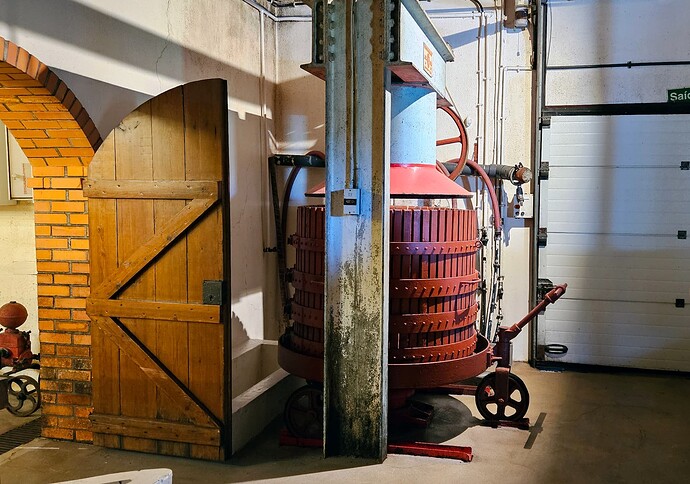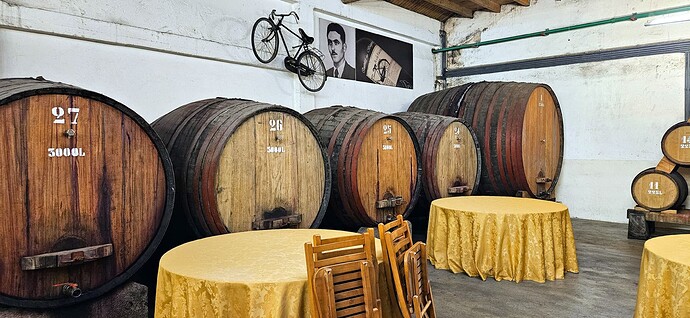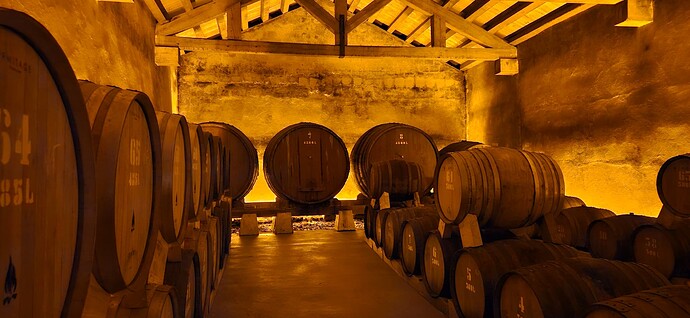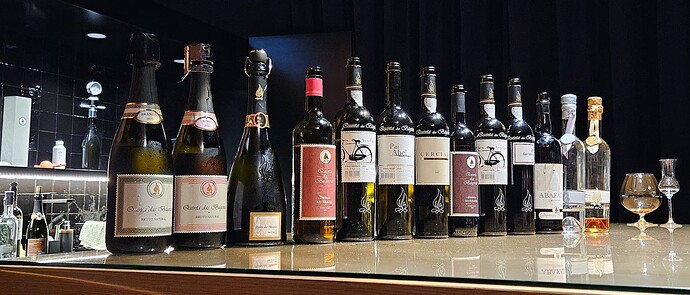Day 2 continues.
From restaurant Mugasa we drove a few-minute trip to the nearby winery of Quinta das Bágeiras.
When I asked @Tomas_Costa about any suggestions which producers to visit, his very first suggestion was Quinta das Bágeiras. As I’m always open for new experiences - especially when recommended by people whose taste I can trust - I had no reason to say no!
(FWIW: As Bairrada is probably best known for the wines of the local wine maverick Luís Pato and the wines of his daughter Filipa Pato and her husband William Wouters, we were originally planning on visiting them. However, Pato-Wouters were unable to accommodate us as they are a very small operation and no-one there was free to host us on the day we were in Bairrada, so visit them was a no-go. Conversely, we would’ve been able to visit Luís Pato, but after I messaged them it sounded like they were charging us 40€ per person for a regular enotourism tour and a tasting of a few wines, so we passed the opportunity in lieu of something more interesting).
Quinta das Bágeiras is a family-owned winery located on the outskirts of the town of Fogueira - hence the winery logo (fogueira translates to “bonfire” or “campfire”). The winery originally began as a mixed farm; grape growing was only a small part of what was farmed at the quinta. They didn’t bottle their own wine either - the grapes were either sold off directly or made into bulk wine.
It was only in 1989 when Mário Sérgio Alves Nuno founded the company by joining the vineyards of his paternal grandfather Fausto with those from his maternal grandfather Armando, totaling to 14 hectares (35 acres). With the aid and support of his father Abel, Mário Sérgio has continued to expand the holdings over the years by purchasing the best (or most promising) land to the current 28 hectares (70 acres).
Already from the beginning the goal was to make quality-oriented wines in a very traditional Bairradino fashion. Even today the grapes are hand-picked, nothing is destemmed, the wines are spontaneously fermented in 1000-liter lagares and aged in old, large oak toneis and smaller pipas and basically everything imaginable is done by hand.
When we arrived to the winery - split between two large buildings on both sides of the road - we were welcomed by the newest generation of the family; Mário Sérgio’s son, Frederico. After quick hellos and introductions, he took us to the cellars located beneath the building that housed the tasting room and the cellar door shop.
Before I came to Bairrada I knew that almost all the sparkling wine produced in Portugal comes from Bairrada (and the tiny region Távora-Varosa), I was still surprised how big a thing sparkling wines were for these producers! All I knew about Bairrada before our visit were Baga and Portuguese sparkling wines, so naturally I expected most of the production to be Baga with some sparkling wines and maybe a little bit of white wines. Well, live and learn!
Thousands of sparkling wine bottles aging
sur lattes.
Frederico told us that an impressive 60% of their annual production is actually Espumante, not still wine! What’s even more impressive is that they really do everything by hand there! All the sparkling bottles aging sur pointe in the wooden pupitres are riddled by hand - a task that takes an hour or two per day; all the wines are processed manually by submerging the neck into sub-zero liquid to freeze the leesy part in the neck into an ice plug and every single bottle is disgorged manually in a bottle opener bench.
Thousands of bottles more, aging
sur pointe.
Sure enough, we didn’t see any gyropalettes or cutting-edge sparkling wine disgorgers anywhere!
Frederico showing us the manual disgorger and the system with which they fill up the portion lost during the disgorgement - their
liqueur d’expedition is just dry wine with all their sparkling wines.
The entry-level cuvées represent some 72-80% of their sparkling wine production, meaning that they don’t make their top-range cuvées in every vintage, and in the vintages that they make them, the amount of these bottles is very small.
After we had checked out the sparkling wine cellars we walked to the other
adega right across the road.
This part of the winery was reserved for the fermentation tanks, barrels, lagares and - naturally - two stills. Frederico told us that basically all the barrels in the winery are old (many barrels did look very old) and only their oak-aged aguardente is aged in new oak barrels.
550-liter
pipas and other oak barrels. In the top right corner you can see some of the smaller, new oak barrels in which the
aguardente is aging. Unlike the wines, these barrels are kept in the warmer attic.
Frederico also mentioned that they are also making some balsamic vinegar (that ages for 10 years in oak barrels) but they keep these barrels in a completely different building, naturally. You really don’t want any acetobacteria floating around in a winery!
The stainless steel tanks are mainly used for the sparkling wines and entry-level wines.
The red wines are vinified in concrete
lagares, where the must stays in contact with the grape skins for 5-8 days, after which the wine is racked into oak barrels and the pomace is pressed in an old basket press.
The basket press.
Some old oak
toneis (and avô Fausto in the background!)
Most of the oak barrels were kept in this part of the building; here only the walking surface is covered, whereas the barrels are kept on uncovered earth - which helps in keeping the level of humidity high enough.
Frederico also showed us the two stills they had - a Charentais alembic for distilling wine and a column still for distilling pomace - but as there were some people having lunch right next to them, I chose to just take a quick peek and not take any pictures!
Then we returned to the first adega for the final part of our visit - the tasting!
While we tasted, Frederico told us more details how this family winery operates: the sparkling wines are his main responsibility, whereas his father Mário is the master blender of the oak-aged aguardentes and his grandfather Abel hasn’t retired but is still taking part in the operations, driving around the vineyards in his tractor. When we noticed that there is no guiding notch in the bottom of the bottle for the labeling machine, we asked how the labels get aligned with the company logo, Frederico told that naturally his grandmother labels the wines by hand - supposedly she likes that it keeps her busy!
He also told us how most of the other varieties do just fine in the flat clayey limestone soil of Bairrada (the name actually comes from barro, meaning “clay”) but Baga doesn’t ripen that well in these vineyards. That’s why Quinta das Bágeiras has acquired more vineyards from the hillsides, where one can find abandoned vineyards or plots that are impossible to farm with machines - these are the places in which Baga thrives! As a specialty, they also have a few hectares of Cercial. This variety is not related to the Sercial of Madeira, but is the same variety that is widely cultivated in Dão as Cerceal Branco. Cercial is a finicky variety to grow in Bairrada, but at the moment Quinta das Bágeiras is attempting to make use of the full potential of the grape variety, making it into one of the very few varietal Bairradino Cercials!
- 2022 Quinta das Bágeiras Bairrada Espumante Bruto Natural - Portugal, Beiras, Bairrada (22.4.2024)
Typically a blend of Bical (50%) and Maria Gomes (50%), but might include tiny additions of Baga or Cerceal Branco as well. The grapes are crushed, then moved into 1000-liter bins for a day or two for a quick settling. Fermented spontaneously and aged on the lees in stainless steel tanks until the March following the harvest, then bottled and aged sur lattes for approximately a year. Riddled and disgorged by hand. 12,5% alcohol, non-dosé. Bottle #24548 of total 49354 bottles.
Pale, youthful yellow-green color. The nose feels a bit closed with slightly reductive aromas of struck match, some fresh appley tones, a little bit of leesy yeast and a hint of waxy funk. The wine feels ripe and youthful yet brisk and bone-dry on the palate with a medium body and crunchy flowers of sharp Granny Smith apple, some fragrant floral character, light steely mineral tones, a little bit of waxy funk, a primary hint of candied tropical fruit and a touch of lemony citrus fruit. The mousse feels silky smooth and the racy acidity lends good sense of freshness and structure to the wine. The finish is fresh, lively and pretty long with a zippy aftertaste of lemony citrus fruits, some floral herby tones, a little bit of waxy funk, light chalky mineral notes, an incisive hint of cool steely character and a touch of leesy yeast.
A nice, brisk and refreshing sparkling wine that is still quite youthful and primary, making the wine feel a bit simple and linear. However, there is a tiniest hint of waxy funk that adds a nice layer of complexity to the appley-and-mineral overall feel to the wine. It's hard to say whether the wine will improve from here, but based on the still slightly primary fruit flavors, I'd let the wine age for at least a few years more, just to blow those sweet fermentation nuances off. All in all, a fresh and sophisticated Método Clássico bubbly. Nothing too flashy or challenging, but nothing to complain, either. A nice weekday fizz. Solid value at 8,25€.
(88 points)
- 2022 Quinta das Bágeiras Bairrada Espumante Bruto Natural Rosé - Portugal, Beiras, Bairrada (22.4.2024)
100% Baga, crushed without any skin maceration, then moved into 1000-liter bins for a day or two for a quick settling. Fermented spontaneously and aged on the lees in stainless steel tanks until the next spring, then bottled and aged sur lattes for approximately a year. Riddled and disgorged by hand. 12,5% alcohol, non-dosé. Bottle #8092 of total 31764 bottles.
Pale rosy color. The nose feels red-toned with aromas of strawberries and some marmaladey primary fruit, some toasty toffee tones, a little bit of leesy yeast and a hint of savory spice. The overall feel is a bit robust rather than fine-tuned. The wine feels brisk and bone-dry on the palate with a medium body and slightly angular flavors of strawberries, some sour cherry bitterness, a little bit of stony minerality, light spicy notes, a hint of something vaguely funky and a touch of ripe raspberry. The wine is not only high in acidity, but there seems to be a tiniest bit of tannic tug on the gums as well. The finish is dry, crisp and precise with a moderately long aftertaste of strawberries, some fresh red cherries, a little bit of stony minerality, light rustic funky nuances, a hint of brambly raspberry and a touch of savory spices.
A nice, fresh and characterful rosé. The somewhat unrelenting character of Baga shines through here and it seems it's a matter of preference whether one likes it or not - I found the wine enjoyable with its understated rusticity and subtle roughness, whereas the other people in our group found the wine lacking a bit too much in finesse. Granted, this is not a Champagne - but it really doesn't even try to be one. This is an honest, hand-crafted Bairrada Baga, and it should be treated as such. Fun stuff; a refreshing and characterful little fizz on its own and a nice food wine for those occasions that call for some firmness and sense of structure from the bubbly. Good value at 8,25€.
(87 points)
- 2018 Quinta das Bágeiras Bairrada Espumante Grande Reserva Bruto Natural Rosado - Portugal, Beiras, Bairrada (22.4.2024)
The flagship rosé bubbly of Bageiras, made only in good enough vintages. 100% Baga, fermented spontaneously. Bottled in the spring following the harvest, aged sur lattes for five years. This is a recent disgorgement. 13% alcohol, non-dosé. Annual production approx. 3000-5000 bottles.
Pale, limpid peachy-orange color with an evolved coppery hue and colorless rim. The nose feels somewhat restrained but also very attractive with nuanced aromas of cooked rose hips, some developed smoky tones, a little bit of fresh red apple, light spicy tones, a hint of something waxy and a touch of toasty nuttiness. The wine feels dry, firm and serious on the palate with a medium body and complex flavors of spicy red apple, some vaguely vegetal notes of carrot, a little bit of tangy salinity, light stony mineral notes, a hint of waxy funk and a touch of ripe citrus fruit. Fine, creamy mousse and brisk, high acidity. The finish is long, dry and quite acid-driven with a complex, palate-cleansing aftertaste of wild strawberries, some stony mineral tones, a little bit of fresh red apple, light toasty notes of chopped nuts, a hint of waxy funk and a touch of tangy salinity.
A very distinctive, nuanced and dead-serious Baga rosé that has a somewhat unique flavor profile, yet doesn't come across as particularly weird in any way. The wine shows a tiny bit of evolution, but the overall feel is still very brisk, youthful and precise with still lots of mileage in the tank. A huge leap in quality and complexity compared to the entry-level sparkling Rosado of Bágeiras. Lovely stuff, priced according to its quality at 35€.
(92 points)
- 2022 Quinta das Bágeiras Bairrada Rosé Reserva - Portugal, Beiras, Bairrada (22.4.2024)
A blend of Baga and Touriga Nacional. Fermented spontaneously, aged in stainless steel tanks. 13% alcohol. Bottle #73of total 3294 bottles.
Pale rosy color. The nose feels a bit reticent with light aromas of strawberries, some fresh yellow fruits, a little bit of savory spice and a hint of sponti funk. The wine feels dry, crunchy and even somewhat angular on the palate, yet at the same time having a slightly oily texture. The wine is medium in body with flavors of sour cherries, some lemony citrus fruits, a little bit of waxy funk, light wild strawberry tones, a tart hint of lingonberry and a touch of stony minerality. The moderately high acidity gives the wine nice sense of balance, but there's a tiniest suggestion of tannins that lend some additional firmness to the mouthfeel. The finish is dry and crunchy with a moderately long aftertaste of wild strawberries, some sour cherry bitterness, a little bit of stony minerality, light tart notes of lingonberries and a hint of waxy funk.
A nice and balanced albeit a bit simple rosado. Nothing too ambitious, but nothing to complain, either. I guess it's once again the Baga component that lends the wine its somewhat rustic charm - the wine isn't a soft and gentle summer sipper, but there's some roughness around the edges as the wine sports a little bit of sour cherry bitterness and the fruit department is more tart and savory rather than soft and fruity. This is definitely not a crowdpleaser, but instead a refreshing, somewhat gastronomic rosé right up my alley! I only wish the wine showed a bit more depth and complexity as it feels maybe a tad linear and mundane now. Maybe time will help? Good value at 9,50€.
(88 points)
- 2022 Quinta das Bágeiras Bairrada Avô Fausto - Portugal, Beiras, Bairrada (22.4.2024)
100% Maria Gomes (aka. Fernão Pires) from a low-yielding vineyard that is harvested early in order to produce a lighter wine with higher levels of acidity. Fermented spontaneously, aged for 11-12 months in old French oak barrels and bottled unfined and unfiltered, right before the wines of the new harvest are put into barrels. Named after Fausto, the grandfather of Mário Sérgio who runs the winery now. 13% alcohol.
Pale lemon-yellow color. Nuanced and quite attractive nose with layered aromas of fresh peach, some creamy oak, light floral notes of orange blossom, a little bit of savory spice and a sweeter hint of more tropical fruits. The wine feels rich, textural and quite full-bodied on the palate with layered flavors of sweet Golden Delicious apple, some honeyed tones, a little bit of savory wood spice, light waxy nuances, a hint of apple peel bitterness and a touch of creamy oak. The acidity - surprisingly high for a Maria Gomes - lends great sense of freshness and structure to the wine. The finish is ripe, broad and textural with a long, layered aftertaste of ripe apples, some waxy tones, a little bit of creamy oak, light tropical fruit nuances, a hint of savory wood spice and a touch of apple peel bitterness.
A very lovely, nuanced and harmonious white that manages to combine sense of substance with great freshness - something that isn't always guaranteed with varietal Maria Gomes wines! The oak aging lends lovely sense of creaminess and subtly woody overtones without adding any overt oak aromatics to muddle the fresh-yet-slightly tropical fruit profile. Although the wine is still very youthful, it is eminently drinkable right now. However, I feel this is a wine that could benefit from a few years of additional aging. Good value at 21€.
(91 points)
- 2022 Quinta das Bágeiras Bairrada Pai Abel Rosé - Portugal, Beiras, Bairrada (22.4.2024)
Bágeiras' contribution to the premium rosé genre: this is a blend of Baga (80%) and Touriga Nacional (20%). No skin contact. Fermented spontaneously, aged in old oak. 13% alcohol.
Pale, almost colorless peachy-orange color. The nose feels youthful and characterful yet fine-tuned, not bold, with layered aromas of wild strawberries and melon, some waxy tones, a little bit of savory spice, light crunchy cranberry nuances, a hint of smoke and a touch of leesy creaminess. The wine feels ripe and textural yet dry on the palate with a medium-to-moderately full body and nuanced, slightly restrained flavors of sweet Golden Delicious apples, some sour cherry bitterness, a little bit of honeyed richness, light crunchy cranberry tones, a hint of creaminess and a touch of wild strawberry. The moderately high acidity lends good sense of balance and structure to the wine. The finish is lively, fresh and savory with a fine-tuned aftertaste of ripe wild strawberries, some sour cherry bitterness, a little bit of crunchy cranberry, light creamy tones, a hint of fresh Golden Delicious apple and a touch of melon.
A wonderfully nuanced and elegant rosé that isn't just your soft and fruity everyday rosé, but instead a more restrained effort that doesn't jump at your face, but instead reveals more subtle nuances layer by layer - without coming across as dilute or underwhelming at any point. There's some real sense of finesse here - and the wine is priced accordingly at 35€. At that price, this isn't an affordable weekday quaffer, but it is obvious that the wine isn't trying to be one - and to its credit, it succeeds in that. Priced according to its quality. Fine stuff that can be drunk now, but also aged for a handful of years for additional complexity. Recommended.
(92 points)
- 2020 Quinta das Bágeiras Bairrada Cercial - Portugal, Beiras, Bairrada (22.4.2024)
One of the very few varietal Cercial (or Cerceal) Brancos from Bairrada. The fruit comes from a 2-hectar vineyard and the total production is 900 to 1200 bottles annually. The fruit is crushed, left to settle in a 1000-liter lagar for 24 to 36 hours and then moved into oak casks for spontaneous fermentation. Aged for 6 months in old oak casks, then moved into stainless steel and aged for at least another 6 months. Bottled unfined and unfiltered. 14% alcohol. Bottle #856 of total 1153 bottles.
Medium-deep and quite intense yellow-green color. The nose feels expressive, fragrant and attractive with quite vibrant aromas of acacia honey and meadow flowers, some cantaloupe, light creamy oak tones, a little bit of ginger, a hint of savory wood spice, a touch of hay and a faint petrolly whiff of Riesling-like diesel character. The wine feels ripe, textural and balanced on the palate with a full body and layered flavors of Golden Delicious apple, some juicy nectarine notes, a little bit waxy funk, light woody notes of savory oak spice, a hint of blood orange and a touch of saline minerality. The high acidity lends impressive sense of freshness and structure to the wine. The finish is rich, ripe and persistent with an intense aftertaste of peach and fresh yellow apple, some savory spicy notes, a little bit of ripe orange, light creamy oak tones, a hint of hay and a touch of salinity.
A balanced, characterful and enjoyably complex wine that is sort of big and ripe yet fresh and precise, both at the same time. Maybe like a Portuguese version of Timorasso or Grk, but maybe not that much. There's definitely substance here, but not as much in the weight department than in the body and breadth. It's hard to see how this wine will evolve from here, but I have no doubts this wine will improve for at least a handful of years more and keep for even longer. Not particularly affordable at 50€, but I can see this is the flagship wine of the winery and priced accordingly. A fine and very enjoyable wine, highly recommended.
(93 points)
- 2021 Quinta das Bágeiras Bairrada Reserva - Portugal, Beiras, Bairrada (22.4.2024)
A blend of Baga (60%) and Touriga Nacional (40%). At least a portion of Baga comes from very old vines, but in vintages when Garrafeira Tinto is not produced, all old-vine Baga goes into this wine. The bunches are only crushed but not destemmed and fermented in lagares for 5-8 days. After the main fermentation is over, the pomace is pressed in an old basket press and the wine is moved to old oak toneis and aged for 18 months. Bottled unfined and unfiltered. 13,5% alcohol. Bottle #4811 of total 10666 bottles.
Youthful, luminous and somewhat translucent cherry-red color with a faint blueish hue. The nose feels youthful and fruit-forward with aromas of blueberries and candied primary fruit tones, some peppery spice, a little bit of strawberry, light reductive nuance of struck matchstick, a hint of dark plummy fruit and a touch of fresh cherry. The wine feels dry, firm and crunchy on the palate with a medium body and savory, red-toned flavors of tart lingonberries and crowberries, some peppery tones, a little bit of smoke, light sweeter notes of boysenberries and ripe raspberries, a hint of fresh red plum and a ferrous touch of iron. The overall feel is structure-driven and still quite tightly-knit with its high acidity and quite assertive tannins. The finish is dry, long and grippy with a crunchy aftertaste of tart lingonberries and sour cherry bitterness, some crowberry tones, a little bit of peppery spice, light sanguine notes of salt and iron, a hint of brambly raspberry and a youthful touch of blueberry-driven primary fruit.
A lively, crunchy and still pretty angular Bairrada red that is definitely not a crowdpleaser but as honest as a Baga-driven red can be! Although there is some Touriga Nacional to add a bit of body and darker-toned aromatics to the wine, the emphasis is definitely on the high acidity, ample tannins and red-toned fruit of Baga! If opened now, the wine seems to call for a bit of aeration, and even then the wine feels like it calls for something hearty to soften those tannins. Even if the wine doesn't feel like a big or bold wine, I have no doubts this wine will do just fine even with quite bold dishes. However, I'd rather let the wine age some more, just to lose those primary aromatics and develop some additional tertiary complexity. Most likely the tannins will outlive the fruit here, so I wouldn't age the wine to soften those tannins - I'm pretty sure it will never happen. While not the most complex of Bairrada wines, this is a lovely, youthful red with good sense of place. Terrific value at 11,50€.
(90 points)
- 2021 Quinta das Bágeiras Bairrada Avô Fausto Tinto - Portugal, Beiras, Bairrada (22.4.2024)
A blend of Baga (80%) and Touriga Nacional (20%). The bunches are only crushed but not destemmed and fermented in lagares for 5-8 days. After the main fermentation is over, the pomace is pressed in an old basket press and the wine is moved to old oak barrels from Burgundy to finish fermentation and age. Halfway through the aging process the wine is racked into an old, smaller oak tonel for the remainder. The wine is bottled unfined and unfiltered after approximately 18 months of aging in oak. 12,5% alcohol. Annual production about 2000 bottles.
Luminous and quite translucent cherry-red color. The nose feels lively, savory and crunchy with aromas of dark berries, some tobacco, a little bit of fresh red plum, light sanguine notes of iron, vibrant hints of blueberries and cranberries and a touch of inky character. The wine is dry, sinewy and very crunchy on the palate with a light-to-medium body and bright flavors of sour cherries, some ferrous notes of blood, a little bit of tart lingonberry, light floral notes of violets, a hint of fresh red plum and a touch of gravelly minerality. The high acidity and quite grippy medium-plus tannins lend great sense of freshness, structure and intensity to the wine. The finish is dry, long and quite grippy with a crunchy, characterful aftertaste of tart lingonberries and red plums, some sanguine notes of iron, a little bit of gravelly minerality, light floral tones, a hint of darker-toned forest fruits and a touch of sour cherry bitterness.
Compared to the Bágeiras Bairrada Reserva and Garrafeira, this bottling seems a tad lighter and more delicate in comparison - albeit not lacking a bit in intensity. The combination of relatively light body, ample tannins, high acidity and sour cherry overtones take me quite instantly to Piedmont and this wine wouldn't be out of place if it was placed blind in a tasting of Dolcetto, Freisa and Nebbiolo. Lovely purity, freshness and vibrancy here. The overall feel is pretty youthful, but not at all too primary - however, if opened now, the wine really calls for some food to tame those tannins. Although the wine is maybe a bit lighter and more approachable than the Bágeiras Reserva and Garrafeira bottlings, it is still very much Bairrada Baga at heart. I would let the wine age for another 5-8 years, just to let it resolve a little bit. A wonderful Bairrada red, good value at 24€. Recommended.
(92 points)
- 2019 Quinta das Bágeiras Garrafeira - Portugal, Beiras, Bairrada (22.8.2023)
Baga sourced exclusively from very old vines (up to 90 years and even older) with about 5% other interplanted varieties. The bunches are only crushed but not destemmed and fermented in lagares for 5-8 days. After the main fermentation is over, the pomace is pressed in an old basket press and the wine is moved to old oak toneis and aged for 18 months. Bottled unfined and unfiltered. 13% alcohol. Annual production about 7000 bottles.
Dark, moderately translucent black cherry color. The nuanced nose feels savory with dark-toned aromas of dark forest fruits, some ferrous notes of blood, a little bit of tobacco, light blueberry tones, a woody hint of old oak and a touch of brambly black raspberry. The wine feels dry, firm and sinewy on the palate with a medium-to-moderately full body and intense flavors of sour cherries and tart lingonberries, some inky tones, a little bit of crunchy crowberry, light gravelly mineral tones, a hint of tobacco and a ferrous touch of blood. The wine is very structure-driven with its high acidity and assertive, grippy tannins. The finish is long, lively and pretty tannic with a crunchy aftertaste of tart lingonberries and sour cherry bitterness, some darker-toned notes of fresh bilberries, a little bit of tobacco, light gravelly mineral notes, a hint of blood and a touch of ripe cranberry.
A very impressive, savory and tightly-knit Bairrada red that is full of intense old-vine fruit, yet the wine isn't a huge and extracted blockbuster wine, but instead made in a nuanced, slightly low-key style. The overall feel is that of a wine opened way too young - not unlike an old-school Bordeaux or Barbaresco opened right after release. You can taste that there is a very impressive wine lurking underneath, but most of it is still locked out beneath that still very firm, tightly-wound structure. At the moment this is a rather tough - but not austere or aggressive - wine that screams for additional age. Terrific stuff with tons of upside - expect the score to go up as the wine ages. Good value at 30€. Highly recommended.
(93 points)
- NV Quinta das Bágeiras Bairrada Abafado - Portugal, Beiras, Bairrada (22.4.2024)
100% Baga. The bunches are only crushed but not destemmed and fermented in lagares until the level of residual sugar reaches the level of about 75 g/l, at which point the fermentation is halted by 70% aguardente distilled at the estate. The fortified wine is moved into old oak barrels and left to age for approximately 15 years. This wine is 18,5% in alcohol, approx. 80 g/l in residual sugar and it is composed of vintages 2004, 2005 and 2007. Bottle #170 of total 1039 bottles.
Very slightly hazy caramel-brown color with a reddish maroon hue. The rich nose feels very attractive with layered aromas of caramel and toffee, some oxidative nutty tones, a little bit of dried dark fruits, light smoky nuances, a hint of arrack and a touch of jammy red berries. The wine feels rich, sweet and somewhat spicy on the palate with a full body and complex flavors of syrupy molasses and dried fruits, some arrack, light raisiny tones, a little bit of butterscotch, oxidative hints of chopped nuts and caramel and a touch of Christmas spices. The moderately high acidity keeps the wine enjoyably in balance. The finish is rich, complex and somewhat oxidative with a sweet, layered aftertaste of caramel and prunes, some raisiny tones, a little bit of Christmas spices, light oxidative nutty nuances, a hint of arrack and a touch of toffee.
A wonderfully nuanced, complex and delicious fortified wine made in a style of a Tawny Port, yet the overall style feels a bit lighter and less burly compared to Tawny Ports, making this come across more like a missing link between a Tawny Port and a Bual Madeira. I guess the somewhat cooler and more Atlantic climate of Bairrada, the higher acidity of Baga and the slightly lower level of residual sugar all contribute to the sense of freshness and sophistication here. I guess the high quality of the estate-distilled aguardente should not be forgotten, either! All in all, this is a delicious, less rich and more delicate alternative to a 20-yo Tawny Port. I doubt it will evolve much or at all in the bottle, but it won't fall apart anytime soon, either. Solid value at 32,50€. Highly recommended!
(93 points)
- NV Quinta das Bágeiras Aguardente Bagaceira - Portugal (22.4.2024)
An aguardente bagaceira distilled from the bagaços - ie. grape pomace - of pressed red grapes that have not been destemmed, immediately after finishing the red wine fermentation. The pomace is distilled in a column still, resulting in a quite neutral and very strong spirit. Bottled at the strength of 50% alcohol.
Neutral, crystal-clear color. Surprisingly clean and mildly fruity nose - more on the neutral side than veering towards the grappa funk. Light-bodied, neutral and rather hot on the palate with vague fruity notes and some alcohol sweetness along with a rather punchy blast of boozy heat. The finish is hot, rather clean somewhat round with a mild white-fruited note and a hint of alcohol sweetness.
A very clean, pure and neutral artisanal Bagaceira with great sense of purity and nice round overall character. An enjoyable digestif, although this kind of purity will probably speak more to the vodka drinkers - I would've welcomed a bit more grappa funk and some roughness around the edges! This is pretty much as pure as these grappa / bagaceira / marc spirits come, but admit I do I prefer something less neutral and a bit more characterful (and I might be in a minority with this view). Priced according to its quality at 17,50€ for a half-liter bottle.
- NV Quinta das Bágeiras Aguardente Vinica Velha - Portugal (22.4.2024)
An oak-aged aguardente made predominantly with early-harvested Baga, blended with the leesy decanted portions of white varieties that didn't make into barrel. Distilled in an old Charentais alembic still. Aged in new 50, 100 and 550-liter oak barrels that are kept in the warm, humid attic level of the winery. Originally this was a blend of spirits averaging 10 years in age, but since the winery has retained a bit more of their spirits than what they bottle annually, the average age of the spirits has crept up a little and today the average years is a few years above the original 10 years. Bottled at the strength of 40,5% alcohol.
Deep, luminous nutty-brown or pale coppery color. The nose feels concentrated and quite sweet with layered aromas of caramel, some butterscotch, light fragrant notes of arrack, a little bit of vanilla and other baking spices, a floral hint of wild honey and a touch of toasty wood. The spirit feels quite broad, somewhat warm and rather mellow on the palate with a dry and spicy yet not particularly robust overall feel. Although there is no noticeable sweetness, the rich, concentrated flavors give an illusion of sweetness, exhibiting notes of caramel and dried apricot, some savory woody tones, a little bit of butterscotch, light vanilla nuances, a hint of arrack and a touch of bitter medicinal spices. The mouthfeel is very slightly oily, but the spirit feels relatively light on its feet. The finish is long, warm and dry with a complex aftertaste of caramel, some burnt sugar bitterness, a little bit of vanilla, light honeyed nuances, a hint of dried apricot and a woody touch of savory oak spice.
An attractive, elegant and tasty aguardente. Despite being fully dry, there is enough concentration and evolved, sweet-toned flavors that the spirit gives a wonderful sense of illusion - without the lack of weight and that slightly syrupy mouthfeel that comes with higher levels of residual sugar. A very clean, characterful and thoroughly enjoyable effort. Highly recommended. An excellent purchase at 25€ for a half-liter bottle.
It was absolutely interesting to hear some wonderful tidbits of information while tasting through these! For example Frederico reminded us how the Port producers are not allowed to distill their own aguardente for the fortification of their wine, whereas there are no such limitations in Bairrada! That is why they can control the quality of their own aguardente, making Abafado a completely estate-made fortified wine!
It was also very interesting to learn that diluting alcohol with water results in an exothermic reaction, ie. the mixture rises in temperature! This is why they can’t dilute their spirits to bottling strength at one go, because all the aromas they have in their distillate would simply boil off! Instead they have to add water slowly, about one liter at a time, letting the spirit cool down, then repeating the process until the target ABV is reached.
Anyways, after we had tasted the wines, we were planning to make a small purchase of wines. However, plans changed after we learned that they deliver wine to Finland at a reasonable cost, so we purchased in total something like six cases of wine instead - and thanked our wonderful host for this wonderful opportunity to see the winery and taste their wines.
Before we left Finland I had messaged the nearby Caves São João that we’d visit them in the evening if we had any time after our visit to Quinta das Bágeiras. At that point it was 5:40 pm and Caves São João was closing at 6 pm; we were about to give up, but in the end we decided that we’d go to see if they were still open and - if nothing else - we’d just buy a few bottles and be on our way.
But you know how these things go. Right?
![]()
![]()
